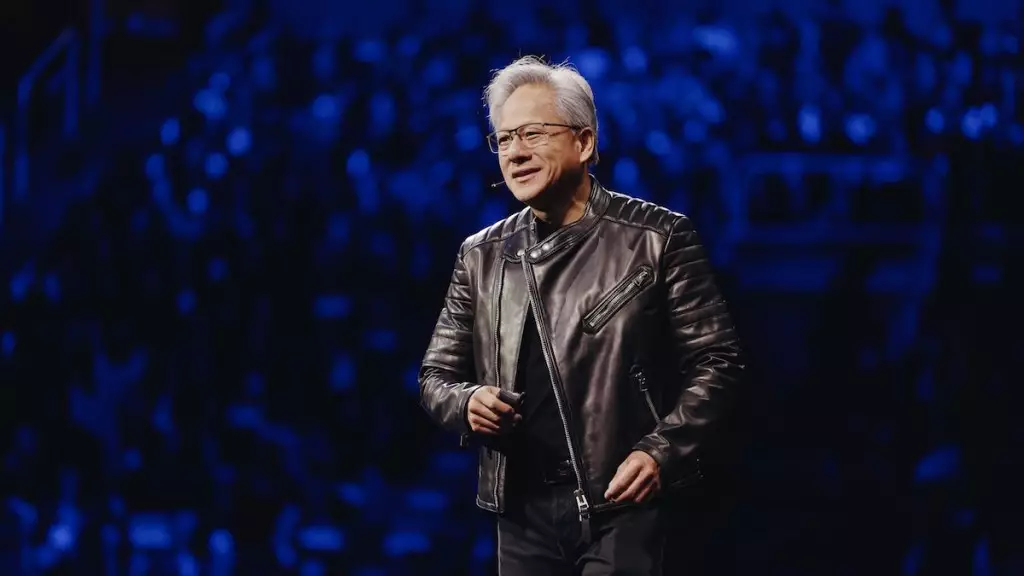The world is standing at the precipice of an artificial intelligence renaissance, a transformative era powered by sophisticated reasoning models that are essential for producing both autonomous agents and physical AI. In a groundbreaking presentation at the GTC conference, Jensen Huang, CEO of NVIDIA, highlighted the unprecedented surges in computational demand required to transition from mere training of AI models to full-scale inference in production settings. This shift is not just about numbers; it’s about reimagining entire data centers as AI “factories,” built to efficiently handle millions of user queries with lightning speed and unparalleled effectiveness.
NVIDIA’s recent advancements, notably the introduction of the Blackwell Ultra AI platform, reflect the company’s unwavering commitment to this shift. This cutting-edge technology delivers a staggering 40x improvement over its predecessor, Hopper, setting a new standard for AI model training and inference. In this evolving landscape, efficiency and scalability are not merely beneficial; they are imperative for organizations looking to leverage AI’s full capabilities. As these factories ramp up production, the potential economic opportunities—estimated at around $1 trillion—illustrate just how critical these innovations are.
Revolutionizing Infrastructure and Performance
One of the standout features of NVIDIA’s latest offerings is the incorporation of Vera Rubin, aimed at dramatically increasing performance and efficiency in AI data centers. For organizations entrenched in AI development, the implications are profound. Beyond the obvious enhancements to GPU technology, NVIDIA is also pioneering advancements in photonics and AI-optimized storage solutions. Such innovations represent a foundational shift in how AI infrastructure is constructed, leading to enhanced scalability that can adapt and grow alongside burgeoning AI demands.
The potential of this infrastructure doesn’t just sit within the confines of a data center. Huang’s vision spans the vast landscape of physical AI applications, noting that the related market could be worth a staggering $50 trillion. Industries ranging from healthcare to logistics stand on the brink of radical change, as AI-driven automation promises to redefine established processes and workflows.
The Road Ahead: Accelerated Innovations
As has become customary for NVIDIA, a clear roadmap has been laid out for the future developments in AI technology. The introduction of Vera Rubin in late 2026 and the subsequent launch of Vera Rubin Ultra in 2027 are pivotal steps forward. With increased speeds in data transfer among chips—critical for large-scale AI applications—these new technologies will provide a robust backbone for the next generation of AI systems.
Moreover, the scheduled release of the Feynman architecture in 2028, which makes use of next-gen HBM memory, further anticipates the future demands of AI computation. The implications of these advancements are vast, promising a synergy of speed and efficiency that will push the boundaries of what is currently possible.
Empowering Individuals with Personal AI Technology
In a bold move to democratize AI capabilities, NVIDIA is launching DGX Personal AI computers built on the Grace Blackwell platform. These innovative machines are designed for power users who wish to develop, refine, and deploy large AI models directly from their desktops. Partnerships with major manufacturers like ASUS, Dell, and HP will ensure accessibility and reach, allowing a broader audience to engage with advanced AI capabilities.
In parallel, the advent of Spectrum-X and Quantum-X networking platforms introduces next-level connectivity, enabling AI factories to seamlessly interconnect millions of GPUs while simultaneously reducing energy consumption. This innovative approach to networking could be a game-changer, as energy efficiency becomes increasingly critical in the context of sustainable tech development.
Innovating Across Domains
NVIDIA’s ambitions extend beyond traditional AI sectors. The introduction of open-source tools like Dynamo software streamlines multi-step reasoning processes, thereby accelerating innovation cycles in AI factories. Meanwhile, initiatives such as the NVIDIA Accelerated Quantum Research Center aim to catalyze advancements in quantum computing, in collaboration with leading technical community players.
Furthermore, the unveiling of the GR00T N1 model marks a pivotal development in humanoid robotics. By establishing an open, customizable foundation for reasoning and skills, GR00T N1 opens new avenues for AI in physical machines, blending advanced cognitive processing with intricate physical tasks.
This wave of transformation is underscored by collaborative ventures, like the Newton Physics Engine project with Google DeepMind, which aims to empower robots with the ability to refine their complex task handling. Such collaborations illustrate the broader ecosystem of innovation, where merging expertise leads to groundbreaking advancements.
Through its relentless pursuit of improving AI architecture, NVIDIA is not just participating in the AI revolution; it is amplifying its trajectory, setting the tone for an entire industry poised for extraordinary growth.

